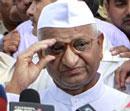
New Delhi, July 29: Measly turnout at his rallies seems to have impacted Anna Hazare the least, as the septuagenarian announced that he will launch an indefinite fast from Sunday.
“I will fast until we get the Jan Lokpal,” Hazare said, addressing a crowd not exceeding 1,000 people. Accusing the government of “cheating” on the Lokpal Bill issue, Hazare said he is “forced to fast repeatedly, which is not a happy thing.”
He had earlier set a deadline of Saturday before the government to accede to his demands.
Though Hazare reiterated that he will neither contest in the 2014 election nor form a political party, he said the country is not “safe” with the Congress or the BJP at the helm.
Speaking of a change at the Centre, Hazare said he will tour the country extensively and urge people to select candidates to contest the election. His team will verify the background of those candidates and put up their names on the internet, seeking public opinion. “From them, we will put some people to contest elections,” he said, adding that “good people should enter the Parliament” to change the system and implement a strong Lokpal.
“For a vote, money is given to the voters. Those who get elected are making money and they don't know where to keep this money. So they send it to foreign countries. Now it’s time to awaken the voters,” he said.
‘Thin crowds no problem’
Replying to the questions on the receding public support for him, which is reflected in the thin turn out at his rallies, Hazare said: “By getting crowds alone, you won't get the work done. You have to work hard for it.”
Hazare’s close aide Arvind Kejriwal appealed the Gandhian activist not to sit on fast because of health reasons.
"His health is not well. We lost Mahatma Gandhi at a wrong time, We lost Jaiprakash Narayan early and we cannot afford to lose Anna now. So I request Anna not to fast," Keriwal said minutes after a team of around 50 Anna supporters staged a protest outside 7 Race Course house, the residence of Prime Minister Manmohan Singh.





Comments
Add new comment